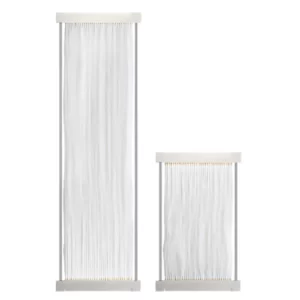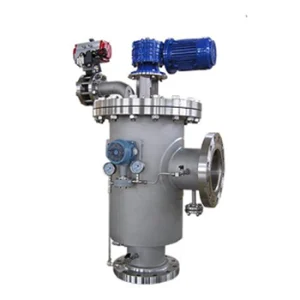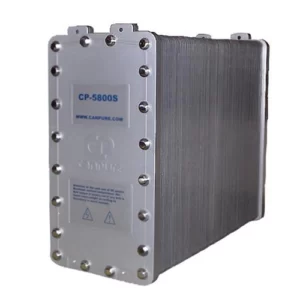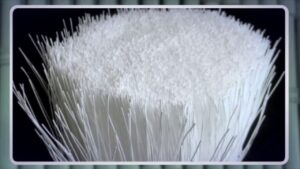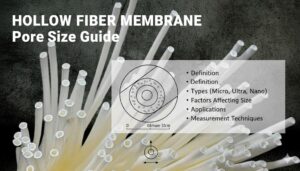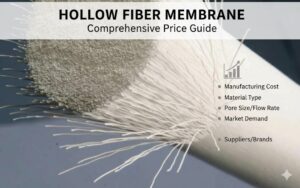If you’re looking to invest in hollow fiber membranes for your water treatment project, you’re probably wondering about one thing:
What’s the hollow fiber membrane price going to set you back?
Here’s the deal:
Hollow fiber membrane costs vary WILDLY. We’re talking anywhere from $45 for a small residential unit to over $6,000 for industrial-grade modules.
In this guide, as a professional hollow fiber membrane manufacturer, I’ll break down exactly what influences these prices and how to get the best value for your specific needs.

What Are Hollow Fiber Membranes (And Why Should You Care)?
Before we dive into pricing, let’s quickly cover what these things actually do.
Hollow fiber membranes are basically tiny tubes (think: human hair thickness) bundled together that filter water, chemicals, or gases. They’re the workhorses behind everything from drinking water purification to pharmaceutical manufacturing.
Why are they so popular?
Simple: They pack a TON of filtration surface area into a small space.
For example, a single industrial module the size of a large coffee can might contain enough membrane surface area to cover a tennis court.
Pretty wild, right?
Hollow Fiber Membrane Price: Current Market(2025 Update)
Let me give you the real numbers based on what suppliers are charging right now:
Small-Scale/Lab Modules
- Price range: $70-$300 per module
- Best for: Research, testing, small batches
- Surface area: Usually under 500 cm²
Residential/Light Commercial
- Price range: $45-$500 per module
- Best for: Home water systems, small businesses
- Flow rates: Up to 5,000 gallons per day
Industrial Modules
- Price range: $400-$6,000+ per module
- Best for: Municipal water treatment, large factories
- Flow rates: 10,000+ gallons per day
Here’s a real example:
I recently helped a food processing plant upgrade their filtration system. They needed PVDF hollow fiber modules for their ultrafiltration setup. The quote? $1,200 per module for 4″ x 40″ units.
But here’s where it gets interesting…
When they ordered 50 units instead of 10, the price dropped to $980 per module. That’s an 18% discount just for buying in bulk.
The 5 Factors That Drive Hollow Fiber Membrane Costs
1. Material Type
The membrane material is the #1 price driver.
Here’s how they stack up:
PVDF (Polyvinylidene Fluoride)
- Most popular for water treatment
- $12-45 per square meter
- Great chemical resistance
PES (Polyethersulfone)
- Common in biotech applications
- $15-40 per square meter
- High flux rates
Ceramic
- Ultra-durable but pricey
- $100-1,000+ per square meter
- Handles extreme conditions
PTFE (Teflon)
- For aggressive chemicals
- $20-50 per square meter
- Superior chemical resistance
Pro tip: Unless you’re dealing with extreme pH or temperatures, PVDF gives you the best bang for your buck.
2. Module Size and Configuration
Bigger isn’t always more expensive per square meter.
In fact, it’s often the opposite.
A 2.5″ module might cost $200 with 5 m² of membrane area ($40/m²).
But a 4″ module with 40 m² might run $1,500 ($37.50/m²).
The sweet spot?
For most commercial applications, 4″ x 40″ modules offer the best price-to-performance ratio.
3. Pore Size and Performance Specs
Tighter filtration = higher price.
Here’s what I’ve seen:
- Microfiltration (0.1-0.2 μm): Base price
- Ultrafiltration (0.01-0.1 μm): 10-20% premium
- Nanofiltration (0.001-0.01 μm): 30-50% premium
4. Brand and Quality
Like anything else, you get what you pay for.
Top-tier brands like Toray, DuPont, and Koch charge 20-40% more than generic alternatives.
Is it worth it?
Often, yes.
Here’s why:
I’ve seen cheap membranes fail after 6 months. Meanwhile, quality modules can run for 5-10 years with proper maintenance.
Do the math on replacement costs, and that premium starts looking like a bargain.
5. Order Volume
This is where you can save serious money.
Most suppliers offer tiered pricing:
- 1-9 modules: List price
- 10-49 modules: 10-15% discount
- 50-99 modules: 15-25% discount
- 100+ modules: 25-35% discount
How to Get the Best Hollow Fiber Membrane Price (Without Sacrificing Quality)
Want to slash your hollow fiber membrane costs? Here’s exactly how to do it:
1. Buy Direct From Manufacturers
Skip the middleman.
I’ve seen markups of 30-50% when buying through distributors.
Platforms like Alibaba can connect you directly with manufacturers. Just make sure to:
- Request samples first
- Check certifications (NSF, FDA, etc.)
- Get references from other buyers
2. Consider “Off-Brand” Options
Not every application needs a premium membrane.
For non-critical uses, quality Asian manufacturers offer modules at 40-60% less than Western brands.
The catch?
You’ll need to do more due diligence on quality control.
3. Time Your Purchase Right
Membrane prices fluctuate with raw material costs.
Oil prices affect polymer costs, which affects membrane prices.
I’ve seen prices swing 15-20% over a few months.
If you can, buy when oil prices dip.
4. Negotiate Service Packages
Here’s something most people miss:
Suppliers often bundle membranes with service contracts.
A membrane might list at $1,000. But add a 3-year service agreement, and they’ll drop it to $850.
Even if you don’t need the full service, this can be a great deal.
5. Consider Refurbished Options
For non-potable water applications, refurbished membranes can save 50-70%.
These are used modules that have been cleaned, tested, and re-certified.
Perfect for:
- Cooling water treatment
- Pre-treatment systems
- Backup units
Real Hollow Fiber Membrane Cost Analysis: Beyond the Sticker Price
Here’s what most buyers miss:
The membrane price is just the beginning.
Let me show you the REAL costs:
Initial Investment
- Membranes: $10,000
- Housing/piping: $3,000
- Installation: $2,000
- Total: $15,000
Annual Operating Costs
- Energy: $1,200
- Cleaning chemicals: $800
- Maintenance labor: $1,500
- Total: $3,500/year
Replacement Schedule
- Membrane lifespan: 5 years
- Annual amortized cost: $2,000
True Annual Cost: $5,500
See the pattern?
Operating costs can exceed the membrane price within 2-3 years.
That’s why paying 20% more for an energy-efficient membrane often pays for itself.
Market Trends and Future Pricing (2025 Outlook)
Based on current trends, here’s what I’m seeing:
Prices Rising 5-8% Annually
Raw material inflation is real.
PVDF resin costs have climbed steadily, pushing membrane prices up.
New Materials Coming Online
Graphene oxide and other advanced materials promise better performance at lower costs.
But don’t hold your breath. Commercial availability is still 3-5 years out.
Asian Manufacturers Gaining Ground
Chinese and Korean suppliers now match Western quality at 60-70% of the price.
This competition is keeping overall market prices in check.
Supplier Comparison: Who to Buy From
Let me break down the major players:
Toray Industries
- Premium quality
- $45-60/m² for hollow fiber
- Excellent for critical applications
DuPont
- Wide range of materials
- $30-50/m² typical
- Strong technical support
Asahi Kasei
- Best value for MBR systems
- $12-20/m² in bulk
- Popular in Asia
Koch Separation Solutions
- Ceramic specialist
- $100-500/m² for ceramic HF
- Unmatched durability
Pentair
- Good mid-range option
- $25-40/m²
- Solid warranties
Smart Buying Checklist
Before you pull the trigger on any purchase:
✓ Calculate total cost of ownership (not just membrane price)
✓ Get quotes from at least 3 suppliers
✓ Request performance data for your specific application
✓ Check warranty terms (should be 1-3 years minimum)
✓ Verify certifications match your needs
✓ Consider pilot testing for large projects
✓ Factor in shipping costs (can be 5-10% of order)
✓ Ask about volume discounts
✓ Understand cleaning/maintenance requirements
✓ Plan for future expansion needs
Making the Right Choice
Here’s the bottom line:
The “best” hollow fiber membrane isn’t the cheapest or most expensive.
It’s the one that delivers the lowest cost per gallon treated over its lifetime.
A $1,500 membrane that lasts 10 years beats a $500 membrane that fails after 2 years.
Every time.
Focus on value, not price.
And remember: proper sizing and system design matter more than the membrane brand.
An expertly designed system with mid-range membranes will outperform a poorly designed system with premium membranes.
Final Thoughts
Hollow fiber membrane pricing doesn’t have to be a mystery.
Armed with this guide, you now know:
- Current market prices across all categories
- The 5 key factors driving costs
- How to negotiate better deals
- What to look for beyond sticker price
The global market for these membranes is exploding. By 2029, we’re looking at a $20 billion industry.
That growth means more options, better technology, and competitive pricing for buyers who know what they’re doing.
Now you’re one of them.
Ready to make your purchase? Start by defining your exact needs, then work backward to find the right hollow fiber membrane price point for your application.

